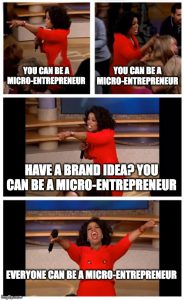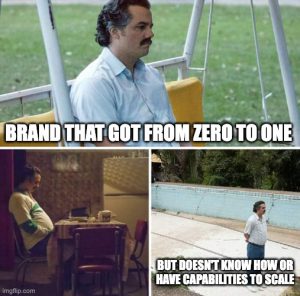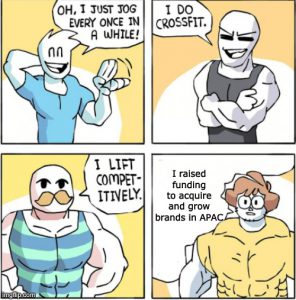What does it take to build a digital-first house of brands in the Asia-Pacific region? In the context of this ecommerce micro-entrepreneur boom, we take a look at the foundations of a next generation house of brands through the lens of ecommerce aggregator Rainforest and the progress they have made since launching in 2021, with insights from Yongcheng Ong, VP of Investments at Insignia Ventures Partners, who also focuses on consumer investments.
Yongcheng Ong is Vice President of Investments at Insignia Ventures Partners. Previously he spent three years at China-based Qiming Ventures as an associate for their investment team in Southeast Asia and before that was part of Sea Group’s Corporate Development and Strategy team as well as Deutsche Bank’s Structured Commodity Finance team. He graduated from Nanyang Technological University with a Bachelor’s Degree in Accountancy.
Highlights
- The story of the ecommerce boom is also a story of an explosion in micro-entrepreneurs who are now able to bootstrap and create brands from scratch and quickly find an initial base of customers online.
- The diversification of distribution, consumers, manufacturing may have lowered barriers for brands to get from zero to one, but getting to the next level is another challenge altogether. For these brands looking to level up their expansion and the back-end needed to support this, ecommerce brand aggregators like Rainforest come into the picture.
- The idea of companies buying out other brands and then taking them to the next level is nothing new but the difference with the digital-first approach is that the resources needed and benchmarks used for a successful brand require a team and approach fit for the world of ecommerce.
When it comes to the global ecommerce boom, especially in Southeast Asia, we often talk about how consumers are going online in droves to find everything from A to Z, driving adoption of online marketplaces of all sorts and upping the game for logistics and payments to keep up.
The ecommerce boom is not just the story of the consumer; it’s also the story of the micro-entrepreneur
But the story of the ecommerce boom is not limited to increasingly digitally savvy consumers and accessible marketplaces. It’s also a story of an explosion in micro-entrepreneurs who are now able to bootstrap and create brands from scratch and quickly find an initial base of customers online. From influencers and content creators selling “merch” to your neighbor selling custom jewelry from their home, the barriers to ecommerce entrepreneurship have never been so low.
“The part that for me is pleasantly surprising is really the diversity and the sheer number of micro entrepreneurs out there, the number of people actually creating their own brands on very little capital. They don’t actually take venture capital. They just bootstrap themselves and create their own brands from scratch. So everything from kitchen products to home products, everything you can imagine, the ability for anyone to sort of go down the entrepreneurship path, the barriers are so low now that anyone can do it. I think that was one of the most amazing things that I’ve seen so far, just talking to all these entrepreneurs who are creating all these brands,” shares ecommerce brand aggregator Rainforest CEO and co-founder JJ Chai on our podcast when asked about his biggest learning since starting the company.
There are a number of reasons for the floodgates being opened for the micro-entrepreneur, especially in emerging markets like Southeast Asia. There’s the diversification of supply chains which now allows products to be made and shipped at lower costs with manufacturing capabilities a lot closer to home for many micro-entrepreneurs.
As JJ explains on our podcast as well, “One of the things that’s quite clear is the cost of getting started and setting up a brand is really low. Now with just $5,000, you can actually order a batch of products and get it made and brand it “Paulo’s Mugs”, and get it going. That has been going on for quite a while now.
What I see happening is the capabilities of the manufacturer are popping up in a few more places around the world. You start seeing people sourcing from alternative sourcing outside China, so everything from Vietnam to Indonesia to India. [There’s also] a bit more [manufacturing capabilities] in there. Still in emerging markets, I would say overall, compared to developed markets, the ability to make goods and import products that are high-quality and distinctive are being a bit more spread out outside this core “China factory of the world” kind of perception that we all have.”
Another reason is of course the proliferation of marketplaces, which have enabled private-label brands to spread their wings (read: sales and revenue) beyond their localities. In 2021, the US$4.9 trillion global ecommerce market saw Amazon global third-party sales hit US$390 billion. There are more than 2 million active sellers on Amazon with an estimated 200,000 third-party sellers with at least US$1 million in revenue, and at least 30% of these sellers are based out of China.
The diversification of distribution, consumers, manufacturing may have lowered barriers for brands to get from zero to one, but getting to the next level is another challenge altogether. Some of these micro-entrepreneurs come to the conclusion that what got them from zero to one isn’t going to get them to 10x and beyond.
Bring the “House of Brands” into Ecommerce
For these brands looking to level up their expansion and the back-end needed to support this, ecommerce brand aggregators like Rainforest come into the picture.
But the idea of companies buying out other brands and then taking them to the next level is nothing new. There are companies like Helen of Troy or LVMH that have long been acquiring or developing brands. The difference with the digital-first approach is that the resources needed and benchmarks used for a successful brand require a team and approach fit for the world of ecommerce.
As JJ explains on the podcast, “The [sign] that we’re hitting success is that we have a growing portfolio of brands with cohesiveness around who’s the buyer behind it, and the categories that we’re in [are] such that there’s more similarities around the people who are buying it. And they start looking at us as a house of brands where we have products for you, right. So if you are of a certain demographic, you have a good chance of having one of our products in your home or in your life.
Like there’s this interesting company called Helen of Troy. If you haven’t heard of it, it’s not unusual. But they actually own brands like Oxo, Revlon, Braun, Hydroflask, Vicks, right? So a house of brands that most people have their products in their home, but no one has any idea [about] Helen of Troy. Similarly for Rainforest, the consumer brands are there. They are part of their lives, but not necessarily the parent company. And we hope to play [in a] similarly meaningful way, but then in a digital first manner, which is if you sort of rethink what a consumer goods company looks like, what do they look like? Will you need so many distributors? How big is the team? Do you need offices in every part of the world? I think we’ll rebuild it in a very different way.”
In this article, we tackle the key foundations of a digital-first house of brands from the perspective of Rainforest and the progress they’ve made over the past two years rapidly building out their portfolio in Asia.
(1) Demographic focus shaping path to category leadership
The first foundation is focus. It’s especially important to have that “distinction” from other houses because the landscape is not a winner-takes-all-category. To date there’s been nearly US$15 billion raised in funding for these types of aggregators which represents less than 4% of Amazon’s third party GMV.
This means that there is room for many category leaders to emerge in Asia with their own specialty or focus in terms of customer segments or target demographics.
For Rainforest, that’s been the mom, with their acquisitions around maternity, baby care, kids, and home categories, all of which are areas where moms are the primary spenders or decision-makers. Their most recent announced acquisition was of baby care brand Naturebond.
Women control over US$31.8 trillion in worldwide spending (more than 7x the global ecommerce market value we cited earlier). 3 in 4 women are primary shoppers for their household, and women control 85% of consumer spending.
These stats paint a picture of a massive market, but more critical for Rainforest’s decision to focus on the mom as the target demographic are the qualitative aspects that easily cut across borders, with moms across cultures known to value quality and safety or price, tending to be sticky or brand loyal, and often lean on communities.
That last aspect in particular opens up opportunities for Rainforest to build or tap into mom-focused communities to support the growth of their portfolio, from feedback loops and brand ambassadors to co-creators of brands at scale.
(2) Portfolio network effects scaling fruits of data, functional expertise, and sourcing
Being digital-first means there are more accessible tools at Rainforest’s disposal to scale revenue. The brands Rainforest typically acquires are looking to scale beyond the Amazon platform and/or their home markets but do not know how, and often have not previously leverage technology on their own to scale.
What’s critical here is that by growing one brand, Rainforest is creating network effects for the rest of its portfolio. With data-driven analysis, brands could learn from each other. The learnings are also easier to translate because, going back to the first foundation, there’s a common target demographic.
Portfolio network effects also scale the functional expertise of their team. Across marketing, platform, product, supply chain, and more, Rainforest has managed to bring together track records in digital-first brand building.
The CEO JJ himself has had more than 10 years of experience scaling brands and companies across markets, like Airbnb and Carousell (personally recruited by Yinglan). His CTO and co-founder Per-Ola Röst was previously CEO of a seller optimization software for Amazon sellers, which brings to the table capabilities to run fulfillment services. Then CFO and co-founder Jason Tan brings 2 decades of experience in banking and fintech including previously CFO-ship in Fave to the table as he oversees the building of Rainforest’s capital moat.
Some of the other leaders in the company are also positioned from experience to take brands online for the long-term, like Head of Acquisitions Yev Ivanko, who himself was an Amazon seller and has had experience with lending propositions for Amazon sellers, and Head of Brands Christine Ng, whose experience lies in building online brands over time, with the likes of Away and Shopbop.
The presence of portfolio network effects also means that Rainforest is not only curating for demographic and needs when looking at potential acquisitions, but also the potential for the brand to achieve regional or product segment leadership. This potential is built on quality and operational track record, and finding these top brands necessitates diversified sourcing channels, especially in a region like the Asia Pacific, where Rainforest is focused on.
As the saying goes, “Tell me what your brands are, and I’ll tell you where you’ll be in the next few years.”
(3) Setting up the house of brands in a prime location in the neighborhood
Speaking of focusing on the Asia Pacific region, and as a company coming out of Southeast Asia, where ecommerce continues to show no signs of slowing down, a brand aggregator like Rainforest building a digital-first house of brands needs to be able to position itself well in the market amidst the unique aspects of operating in this region.
For example, when it comes to the proliferation of brands coming out of China and looking to expand regionally or globally, Rainforest is able to position itself as a bridge between the “East and West” so to speak. Having the ability to understand China’s supply chain and business dynamics, as well as the ability to work in close proximity with Chinese brand owners to scale their business to the next stage of growth, puts them in a prime position to tap into the 30% of the 200,000 brands in the region that have more than US$1 million in revenue (as we cited earlier).
Then there’s also the reality that while Amazon is the dominant marketplace and launchpad for many private-label brands globally, there are also many local marketplaces where a growing number of micro-entrepreneurs are getting their start as well, and it would be remiss for an aggregator not to tap into this as well. The expertise and empathy around Amazon sellers in Rainforest’s team has made Amazon FBA low-hanging fruit, but it’s not where the buck stops for the company’s growth.
Finally, it’s important for any house of brands to consider the capital environment which ultimately fuels acquisitions especially early on. Rainforest has raised more than US$50 million for its acquisitions thus far, and achieved US$30 million in annualized revenue for its first full year of operations. As we’ve cited before, with less than 4% of Amazon’s third-party GMV doled out in funding equivalent in this space, there’s still likely a lot more money to go around, especially as investors keep an eye on this still early development in ecommerce in the region.
3 Foundations of a Digital-First House of Brands in APAC:
- Demographic focus is key for a digital-first house of brands in a market where it’s not winner-takes-all, but winners-are-the-best-at-what-they-do.
- Efficient growth for a digital-first house of brands is achieved through portfolio network effects leveraging data, functional expertise, and sourcing parameters across brands.
- APAC has its own unique environment with the expansion of brands out of China, the diversity of local marketplaces and non-Amazon brands, and the early funding landscape, which is critical for a digital-first house of brands to navigate and build moats around.
Yongcheng Ong is Principal at Insignia Ventures Partners. Previously he spent three years at China-based Qiming Ventures as an associate for their investment team in Southeast Asia and before that was part of Sea Group’s Corporate Development and Strategy team as well as Deutsche Bank’s Structured Commodity Finance team. He graduated from Nanyang Technological University with a Bachelor’s Degree in Accountancy.






